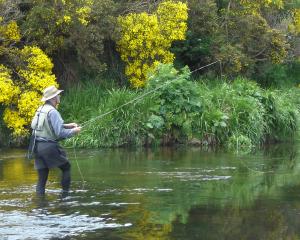

Many anglers dislike low water conditions but it can be an advantage as it allows access to parts of rivers that are normally impossible to get at. It is also easier to find the fish as there is less water for them to hide in.
Exploring rivers when they are low can give information that is useful at normal levels such as where fish are likely to lie when you cannot see them and where can be waded safely.
I looked at a section of the Mataura the other day that I had not seen since the big floods of recent years. It was in a gorgy section that had been scoured out by the floods.
I once fished through the entire section, wading easily up the edge of the river — now it is steep-sided and deep, only accessible from the odd rocky ledge. No doubt it will fill with gravel in time and be fishable again when the water is low.
Lower water temperatures have fish feeding throughout the day again in rivers but the cooler conditions will have put an end to cicada fishing on the tussock lakes until we get a few more warm days.
Evening fishing should still be productive using a sedge imitation on still waters or rivers. On one outing on a cool day there were mayflies hatching until mid-morning.
Both my recent outings have been on the Mataura — one day warm and the other cool. On the cool day, fish were rising to hatching mayflies. I spotted three fish before even making a cast and several more over the next half hour and even managed to catch some of them.
Catching fish straight away sometimes has the rest of the day not living up to expectations but this day fished well throughout. The water was still warm from the hot days before so the fish were predominantly in the ripples.
The best spot to fish in any conditions is the eye of the pool. The eye is at the head of the pool usually at the top of a gravel beach close to the edge of the current where the water becomes shallower. I went to one such spot and caught a fish first cast. The fish took off and I netted it about 30m downstream. After I returned it, I noticed several fish in the deeper water straight in front of me. The weighted nymph did the trick.
The second day was warmer but the water was cool and fish were feeding in the ripples and cruising the flat water and were easy to see and spook. There were very few rises but on the flat water the fish took the unweighted nymph and the weighted version in the ripples.
At the end of the day, I showed great strength of character, leaving a ripple with trout feeding flat out. Still, they will be there next time.


